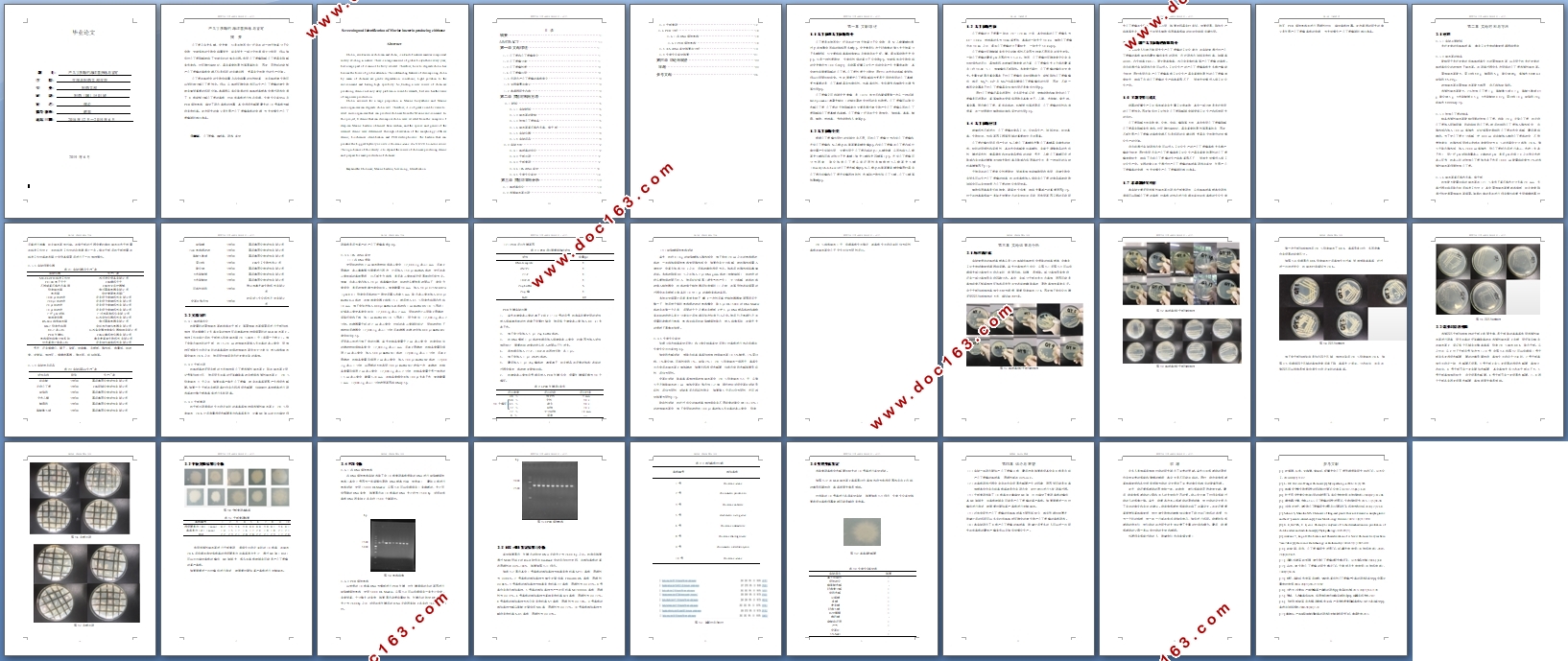产几丁质酶的海洋菌筛选与鉴定

产几丁质酶的海洋菌筛选与鉴定(任务书,开题报告,论文说明书10000字)
摘 要
几丁质又名壳多糖、甲壳素,它是自然界中广泛存在的一种天然高分子化合物,全球每年的生物合成量很大,却有很大一部分无法得到充分利用,所以如何对几丁质降解就成了全球关注的焦点问题。利用几丁质酶降解几丁质具有降解条件温和、对环境污染较轻、具有高度特异性等显著特点,因此,寻找新的能够产几丁质酶的菌株来源不仅是科研的关键问题,更具有无法替代的生产价值。
几丁质在海洋中的生物合成量占总合成量的比例较高,并且海洋微生物可以很好地分解几丁质残余。所以,从海洋环境中遴选可以生产几丁质酶的微生物就有着很重要的科研价值。本课题从武汉取得的深海海洋菌样本中通过筛选获得了8株能够分解几丁质的菌株,对这些菌株进行形态观察、生理生化鉴定以及PCR凝胶电泳,确定了筛出菌株的种属,其中透明水解圈最大的10号菌株为蜡状芽孢杆菌。此次研究的意义是扩展产几丁质酶菌株的来源,为大规模生产几丁质酶做好相应准备。
关键词: 几丁质酶;海洋菌;筛选;鉴定
Screening and Identification of Marine bacteria producing chitinase
Abstract
[版权所有:http://DOC163.com]
Chitin, also known as chitosan and chitin, is a kind of natural macular compound widely existing in nature. There is a large amount of global biosynthesis every year, but a large part of it cannot be fully utilized. Therefore, how to degrade chitin has become the focus of global attention. The outstanding features of decomposing chitin by mean of chitinase are gentle degradation conditions, Light pollution to the environment and having high specificity. So,Finding a new source of chitinase producing strain is not only a key problem in scientific research, but also has the value of large-scale production.
Chitin accounts for a large proportion in Marine biosynthesis and Marine microorganisms can degrade chitin well. Therefore, it is of great scientific value to select microorganisms that can produce chitinase from the Marine environment. In this project, 8 strains that can decompose chitin were selected from the samples of deep-sea Marine bacteria obtained from wuhan, and the species and genus of the screened strains were determined through observation of the morphology of these strains, biochemical identification and PCR electrophoresis. The bacteria that can produce the biggest hydrolysis circle is Bacillus cereus ,the NO.10 bacterial strain. The significance of this study is to expand the source of chitinase producing strains and prepare for mass production of chitinase.
[资料来源:https://www.doc163.com]
Keywords: Chitinase; Marine bacteria; Screening; Identification

目 录
摘要…………………………………………………………………………………I
ABSTRACT………………………………………………………………………II
第一章 文献综述………………………………………………………………1
1.1 几丁质和几丁质酶简介……………………………………………………1 [资料来源:http://doc163.com]
1.2 几丁质酶分类………………………………………………………………1
1.3 几丁质酶性质………………………………………………………………2
1.4 几丁质酶应用………………………………………………………………2
1.5 已筛出产几丁质酶的菌株简介……………………………………………3
1.6 立题背景与意义……………………………………………………………3 [资料来源:http://www.doc163.com]
1.7 本课题研究内容……………………………………………………………3
第二章 实验材料与方法………………………………………………………5
2.1材料…………………………………………………………………………5
2.1.1 实验材料……………………………………………………………5
2.1.2 培养基的配制………………………………………………………5
[资料来源:http://Doc163.com]
2.1.3 胶体几丁质制备……………………………………………………5
2.1.4 培养基高压蒸汽灭菌、倒平板……………………………………5
2.1.5 实验仪器……………………………………………………………6
2.1.6 实验药品……………………………………………………………6
2.2 实验方法……………………………………………………………………7
2.2.1 海洋菌的活化………………………………………………………7 [资料来源:www.doc163.com]
2.2.2平板初筛……………………………………………………………7
2.2.3平板复筛……………………………………………………………7
2.2.4 16S rRNA鉴定……………………………………………………8
2.2.5 生理生化鉴定……………………………………………………10
第三章 实验结果与分析……………………………………………………12
3.1海洋菌活化…………………………………………………………………12
3.2选择培养基初筛……………………………………………………………15
3.3平板复筛……………………………………………………………………17
3.4 PCR分析……………………………………………………………………18
3.4.1总DNA凝胶电泳…………………………………………………18
3.4.2 PCR凝胶电泳……………………………………………………18 [来源:http://www.doc163.com]
3.5 16S rRNA鉴定结果与分析………………………………………………19
3.6生理生化鉴定结果…………………………………………………………21
第四章 结论与展望……………………………………………………………22
致谢………………………………………………………………………………23
参考文献…………………………………………………………………………24
[资料来源:http://Doc163.com]
